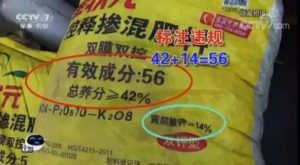True Or False, There Are Many Fertilizer Secrets On The Packaging
True Or False, There Are Many Fertilizer Secrets On The Packaging
The saying says “The banker’s money depends on fat”. This means harvest crops relies on fertilizers. Now is the season that farmer prepares fertilizer in great quantities, chemical fertilizer is a magic weapon for increasing yield and income. The state has always attached great importance to the quality of agricultural materials with constantly standardizing the market& strict supervision, but fake fertilizers still occasionally appeared in the market, how to avoid this? Learn together!
Chemical elements of common fertilizers ———-C,H,O,N,P,K,Ca,Mg,S,Fe,Mn,Zn,Cu,Mo,B,Cl
Generally, N, P2O5 and K2O on the fertilizer bag represent nitrogen, phosphorus pentoxide and potassium oxide respectively, and the corresponding number below represents its percentage in the fertilizer. For example, N, P2O5, K2O written on the top and 18-46-0 on the bottom, indicating that the fertilizer contains 18 kilograms of nitrogen and 46 kilograms of phosphorus pentoxide per 100 kilograms, while the content of potassium oxide is zero, indicating that the fertilizer does not contain potassium.
These symbols also indicate the type of fertilizer. Fertilizers containing nitrogen, phosphorus and potassium are called ternary compound fertilizers, containing only two elements are called binary compound fertilizers, and containing only one element are called single fertilizers. On some fertilizer bags, the word “K2O” is followed by the word “S”, indicating that potassium in the fertilizer is potassium sulfate. If K2O is followed by the word CL, the potassium in the fertilizer is potassium chloride.
Polish your eyes. Check it carefully this way
1. Indiscriminate filling of ingredients posing as content
First of all, we should know that, according to the national standard, the label only indicates the content of nitrogen, phosphorus and potassium. Be sure the element content on packaging above is valued before buying, be cheated in case.
Here’s a concrete example: The package says potassium sulphate type compound fertilizer, but the chemical element below says N:15 p2o5:15 CaMg:15. The fertilizer package does not actually give the amount of potassium, but USES CaMg instead.This CaMg is not potassium, this last number 15 is not potassium. It’s actually a binary compound fertilizer, and it only contents 30%, and CaMg is mistaken for potassium fertilizer.
2. The content is lower than the national standard
Understanding national standards before purchasing helps you to identify unqualified fertilizers. Let’s take a look at two criteria: The enterprise standard numbering format is: Q/ (enterprise code) (4-digit serial number) S- (year number)
The format of the mandatory national standard is: GB (the serial number of the national standard) – (the last two digits of the year of publication)
Very complicated? It doesn’t matter. Remember: the enterprise standard starts with Q, and the mandatory national standard starts with GB. Mandatory national standard means, the standard that the enterprise makes itself, which cannot under national standard. So how does this example mix? “Potassium sulphate for agricultural use” is labeled as Q/ ljh002-2002, and the potassium content is labeled as K2O 42%. It looks under standarded, is it actually so? If you look at this standard, which starts with Q, it’s clearly an enterprise standard. However, if you know the national standard, potassium content is the national mandatory standard, and K2O 45% is qualified product (gb20406-2006, powder qualified product K2O 45.0%). Therefore, this product has played a word game on the packaging, which seems to be standard but actually belongs to unqualified products. Similarly, the N content of urea in nitrogen fertilizer is less than 46%, which is also fake. The implementation standard is Q/ CGYZ003-2006, and the national mandatory standard (GB2440-2001, the qualified product with nitrogen content 46%). If the implementation standard fails to meet this requirement, it is false “urea”.
3. Scribbling content:
The words on the package must be carefully read! This 56% is so obvious in the picture that one would think that the active ingredient of this fertilizer is 56%. But actually at the small printing words below, the total nutrient is actually 42%.The original manufacturers included the original content of potassium fulvic acid (14%) and more calculated fertilizer nutrients, misleading farmers. Even some false compound fertilizer, some use calcium to pretend to be phosphorus, some use unknown chemical elements to pretend to be the total content of nitrogen, phosphorus and potassium, some even use nitrogen fertilizer to pretend to be compound fertilizer, really let the farmer friend true false difficult to distinguish, impossible to prevent.
Tips for buying fertilizers
(1) look at the name and trademark of fertilizer, seeing whether the logo is scribbled.
(2) information such as active ingredient content and net weight. Single fertilizer should be marked single component content, compound fertilizer should be marked N, P2O5, K2O and other components of the percentage and total content, there should also be product standards should be separately marked items, such as chlorine, soluble phosphorus.As stipulated by the state, no element or compound other than nitrogen, phosphorus and potassium shall be included in the total nutrients.
(3) see product standard number.GB, HG, NY.
(4) see the production license number, address of the production or marketing unit, contact number and other valid information.
(5) buy a regular brand product, and don’t forget to ask for the invoice at the same time, in case of problems can be traced.
When spring plowing comes, we farmers should also be more careful to buy fertilizers, so that these fake fertilizers will not cause unnecessary losses.
Summary: Get high-grade fertilizer, manufacturers should put the benefit of farmers in the first place. However, Beidou company has always followed this principle by processing high-quality fertilizer mixing production line; Belt-scale-batching Water Soluble Fertilizer Line and Round Ball Bio Organic Fertilizer Production Line .
This article is contributed by Beidou Overseas Business Department. Welcome you to forward.
B2B, Google, Yourtube, Facebook, Twitter and LinkedIn, you can find us by these methods.
The previous blog is ” 5 Big Lies And 8 Big Sweet-talk Of Fertilizer Industry! ”

